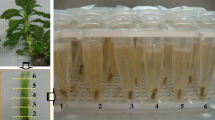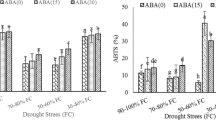Abstract
Tapping panel dryness (TPD) in rubber tree (Hevea brasiliensis) is a complex physiological disorder which causes a serious loss of natural rubber yield. Many studies have been done to uncover the mechanism of TPD occurrence, but the mechanism remains unclear. Previous reports suggested that TPD occurrence might result from the over-generation of reactive oxygen species (ROS). To clarify the roles of ROS scavenging system in TPD response, rubber trees were stimulated by ethephon to induce TPD, and the resultant TPD trees were treated with 1-methylcyclopropene to induce their recovery. The latex samples were collected during the TPD occurrence and recovery to analyze the enzyme activities of catalase (CAT), superoxide dismutase (SOD), ascorbate peroxidase (APX), glutathione peroxidase (GPX) and peroxidase (POD), and the transcript expression of corresponding genes including HbCAT, HbCuZnSOD, HbAPX, HbGPX and HbPOD. The results showed that the activities of these ROS scavenging enzymes and expressions of the related genes got changed during the TPD occurrence and recovery, which suggests that the ROS scavenging genes and their corresponding enzymes were associated with TPD occurrence and recovery. Furthermore, these genes were also regulated by hydrogen peroxide (H2O2) and various hormone treatments, such as methyl jasmonate, salicylic acid, abscisic acid and so on. All these results suggest that the ROS scavenging genes and their corresponding enzymes are involved in responses to TPD, H2O2 and different hormones in rubber tree.







Similar content being viewed by others
References
Zhu J, Zhang Z (2009) Ethylene stimulation of latex production in Hevea brasiliensis. Plant Signal Behav 4:1072–1074
Yusof F, Siti Arija MA, Ghandimathi H, Hamzah Z, Sivakumaran S, Yeang HY (1995) Changes in some physiological latex parameters in relation to over exploitation and the onset of induced tapping panel dryness. J Nat Rubb Res 10:182–198
Dauzac J, Jacob JL, Chrestin H (1989) Biochical aspects of bark dryness induced by over-stimulation of rubber trees with ethrel. In: Chrestin H (ed) Physiology of rubber tree latex. CRC Press, Florida, pp 431–441
Li D, Deng Z, Chen C, Xia Z, Wu M, He P, Chen S (2010) Identification and characterization of genes associated with tapping panel dryness from Hevea brasiliensis latex using suppression subtractive hybridization. BMC Plant Biol 10:140
Zhang Y, Leclercq J, Montoro P (2017) Reactive oxygen species in Hevea brasiliensis latex and relevance to tapping panel dryness. Tree Physiol 37:261–269
Li D, Wu S, Dai L (2020) The rubber tree genome. In: Matsui M, Chow KS (eds) Current progress in transcriptomics and proteomics of latex physiology and metabolism in the Hevea brasiliensis rubber tree. Springer Press, Hoboken, pp 127–129
Das G, Raj S, Pothen J, Sethuraj MR, Sen-Mandi S (1998) Status of free radical and its scavenging system with stimulation in Hevea brasiliensis. Plant Physiol Bioch 25:47–50
Wang X, Wang D, Sun Y, Yang Q, Chang L, Wang L, Meng X, Huang Q, Jin X, Tong Z (2015) Comprehensive proteomics analysis of laticifer latex reveals new insights into ethylene stimulation of natural rubber production. Sci Rep 5:13778
Yuan K, Zhou X, Wang Z, Yang L (2014) Identification and analysis of latex rubber particle proteins related with tapping panel dryness in Hevea brasiliensis. J Nanjing Forestry Univ (Natural Sci Ed) 38:36–40
Venkatachalam P, Thulaseedharan A, Raghothama KG (2007) Identification of expression profiles of tapping panel dryness (TPD) associated genes from the latex of rubber tree (Hevea brasiliensis Muell. Arg.). Planta 226:499–515
Deng Z, Liu H, Wang YK, Li DJ (2014) Molecular cloning and expression analysis of a cytosolic glutathione reductase gene from Hevea brasiliensis. Zhiwu Shengli Xuebao 50:1699–1706
Deng Z, Zhao M, Liu H, Wang Y, Li D (2015) Molecular cloning, expression profiles and characterization of a glutathione reductase in Hevea brasiliensis. Plant Physiol Bioch 96:53–63
Putranto RA, Herlinawati E, Rio M, Leclercq J, Piyatrakul P, Gohet E, Sanier C, Oktavia F, Pirrello J, Kuswanhadi MP (2015) Involvement of ethylene in the latex metabolism and tapping panel dryness of Hevea brasiliensis. Int J Mol Sci 16:17885–17908
Yuan K, Wang Z, Zhou X, Zou Z, Yang L (2014) The identification of differentially expressed latex proteins in healthy and tapping panel dryness (TPD) Hevea brasiliensis trees by iTRAQ and 2D LC–MS/MS. Acta Agric Univ Jiangxiensis 36:650–655
Yuan K, Guo X, Feng C, Hu Y, Liu J, Wang Z (2019) Identification and analysis of a CPYC-type glutaredoxin associated with stress response in rubber trees. Forests 10:158
Hu YY, Bai XQ, Feng CT, Yuan K, Liu H, Wang ZH (2020) Application of 1-MCP to tapping panel dryness of Hevea brasiliensis trees. J Northwest Forestry Univ 35:161–165
Tang C, Qi J, Li H, Zhang C, Wang Y (2007) A convenient and efficient protocol for isolating high-quality RNA from latex of Hevea brasiliensis (para rubber tree). J Bioch Bioph Meth 70:749–754
Long X, He B, Wang C, Fang Y, Qi J, Tang C (2015) Molecular identification and characterization of the pyruvate decarboxylase gene family associated with latex regeneration and stress response in rubber tree. Plant Physiol Bioch 87:35–44
Prasad TK, Anderson MD, Martin BA, Stewart CR (1994) Evidence for chilling-induced oxidative stress in maize seedlings and a regulatory role for hydrogen peroxide. Plant Cell 6:65–74
Apel K, Hirt H (2004) Reactive oxygen species: metabolism, oxidative stress, and signal transduction. Annu Rev Plant Biol 55:373–399
Camejo D, Guzmán-CedeñoÁ MA (2016) Reactive oxygen species, essential molecules, during plant-pathogen interactions. Plant Physiol Bioch 103:10–23
Choudhury FK, Rivero RM, Blumwald E, Mittler R (2017) Reactive oxygen species, abiotic stress and stress combination. Plant J 90:856–867
Segal LM, Wilson RA (2018) Reactive oxygen species metabolism and plant-fungal interactions. Fungal Genet Biol 110:1–9
Mhamdi A, Van Breusegem F (2018) Reactive oxygen species in plant development. Development 145:15
Gill SS, Tuteja N (2010) Reactive oxygen species and antioxidant machinery in abiotic stress tolerance in crop plants. Plant Physiol Bioch 48:909–930
Choudhury S, Panda P, Sahoo L, Panda SK (2013) Reactive oxygen species signaling in plants under abiotic stress. Plant Signal Behav 8:e23681
Hiraga S, Sasaki K, Ito H, Ohashi Y, Matsui H (2001) A large family of class III plant peroxidases. Plant Cell Physiol 42:462–468
Wally O, Punja ZK (2010) Enhanced disease resistance in transgenic carrot (Daucus carota L.) plants over-expressing a rice cationic peroxidase. Planta 232:1229–1239
Quiroga M, Guerrero C, Botella MA, Barcelo A, Amaya I, Medina MI, Alonso FJ (2000) A tomato peroxidase involved in the synthesis of lignin and suberin. Plant Physiol 122:1119–1127
Kawaoka A, Matsunaga E, Endo S, Kondo S, Yoshida K, Shinmyo A, Ebinuma H (2003) Ectopic expression of a horseradish peroxidase enhances growth rate and increases oxidative stress resistance in hybrid aspen. Plant Physiol 132:1177–1185
Passardi F, Cosio C, Penel C, Dunand C (2005) Peroxidases have more functions than a Swiss army knife. Plant Cell Rep 24:255–265
Bindschedler LV, Dewdney J, Blee KA, Stone JM, Asai T, Plotnikov J, Denoux C, Hayes T, Gerrish C, Davies DR, Ausubel FM, Bolwell GP (2006) Peroxidase-dependent apoplastic oxidative burst in Arabidopsis required for pathogen resistance. Plant J 47:851–863
Wang LF (2014) Physiological and molecular responses to drought stress in rubber tree (Hevea brasiliensis Muell. Arg.). Plant Physiol Bioch 83:243–249
Wang LF (2014) Physiological and molecular responses to variation of light intensity in rubber tree (Hevea brasiliensis Muell. Arg.). PLoS ONE 9:e89514
Zhang Y, Leclercq J, Wu S, Ortega-Abboud E, Pointet S, Tang C, Hu S, Montoro P (2019) Genome-wide analysis in Hevea brasiliensis laticifers revealed species-specific post-transcriptional regulations of several redox-related genes. Sci Rep 9:5701
Montoro P, Wu S, Favreau B, Herlinawati E, Labrune C, Martin-Magniette ML, Pointet S, Rio M, Leclercq J, IsmawantoKuswanhadi SD (2018) Transcriptome analysis in Hevea brasiliensis latex revealed changes in hormone signalling pathways during ethephon stimulation and consequent Tapping Panel Dryness. Sci Rep 8:8483
Leclercq J, Martin F, Sanier C, Clement-Vidal A, Fabre D, Oliver G, Lardet L, Ayar A, Peyramard M, Montoro P (2012) Overexpression of a cytosolic isoform of the HbCuZnSOD gene in Hevea brasiliensis changes its response to a water deficit. Plant Mol Biol 80:255–272
Chao J, Zhang S, Chen Y, Tian WM (2015) Cloning, heterologous expression and characterization of ascorbate peroxidase (APX) gene in laticifer cells of rubber tree (Hevea brasiliensis Muell. Arg.). Plant Physiol Bioch 97:331–338
Wang LF, Wang JK, An F, Xie GS (2016) Molecular cloning and characterization of a stress responsive peroxidase gene HbPRX42 from rubber tree. Braz J Bot 39:475–483
Liu ZJ, Guo YK, Bai JG (2010) Exogenous hydrogen peroxide changes antioxidant enzyme activity and protects ultrastructure in leaves of two cucumber ecotypes under osmotic stress. J Plant Growth Regul 29:171–183
Li JT, Qiu ZB, Zhang XW, Wang LS (2011) Exogenous hydrogen peroxide can enhance tolerance of wheat seedlings to salt stress. Acta Physiol Plant 33:835–842
Neill S, Desikan R, Hancock J (2002) Hydrogen peroxide signalling. Curr Opin Plant Biol 5:388–395
Polidoros AN, Scandalios JG (1999) Role of hydrogen peroxide and different classes of antioxidants in the regulation of catalase and glutathione S-transferase gene expression in maize (Zea mays L.). Physiol Plantarum 106:112–120
Almeida JM, Fidalgo F, Confraria A, Santos A, Pires H, Santos I (2005) Effect of hydrogen peroxide on catalase gene expression, isoform activities and levels in leaves of potato sprayed with homobrassinolide and ultrastructural changes in mesophyll cells. Funct Plant Biol 32:707–720
Morita S, Kaminaka H, Masumura T, Tanaka K (1999) Induction of rice cytosolic ascorbate peroxidase mRNA by oxidative stress; the involvement of hydrogen peroxide in oxidative stress signalling. Plant Cell Physiol 40:417–422
Tsai YC, Hong CY, Liu LF, Kao CH (2005) Expression of ascorbate peroxidase and glutathione reductase in roots of rice seedlings in response to NaCl and H2O2. J Plant Physiol 162:291–299
Qin YM, Hu CY, Zhu YX (2008) The ascorbate peroxidase regulated by H2O2 and ethylene is involved in cotton fiber cell elongation by modulating ROS homeostasis. Plant Signal Behav 3(3):194–196
Levine A, Tenhaken R, Dixon R, Lamb C (1994) H2O2 from the oxidative burst orchestrates the plant hypersensitive disease resistance response. Cell 79:583–593
Chen HJ, Wu SD, Huang GJ, Shen CY, Afiyanti M, Li WJ, Linc YH (2012) Expression of a cloned sweet potato catalase SPCAT1 alleviates ethephon-mediated leaf senescence and H2O2 elevation. J Plant Physiol 169:86–97
Agrawal GK, Jwac NS, Iwahashid H, Rakwal R (2003) Importance of ascorbate peroxidases OsAPX1 and OsAPX2 in the rice pathogen response pathways and growth and reproduction revealed by their transcriptional profiling. Gene 322:93–103
Hao BZ, Wu JL (2000) Laticifer differentiation in Hevea brasiliensis: induction by exogenous jasmonic acid and linolenic acid. Ann Bot 85:37–43
Zeng RZ, Duan CF, Li XY, Tian WM, Nie ZY (2009) Vacuolar-type inorganic pyrophosphatase located on the rubber particle in the latex is an essential enzyme in regulation of the rubber biosynthesis in Hevea brasiliensis. Plant Sci 176:602–607
Acknowledgements
We would like to thank Prof. Jiannan Zhou for his revision of the English.
Funding
This research was funded by the Ministry of Agriculture and Rural Affairs of People’s Republic of China (1630022020010) and the China Agriculture Research System-Natural Rubber (CARS-33-ZP1).
Author information
Authors and Affiliations
Corresponding author
Ethics declarations
Conflicts of interest
The authors declare no conflict of interest.
Additional information
Publisher's Note
Springer Nature remains neutral with regard to jurisdictional claims in published maps and institutional affiliations.
Rights and permissions
About this article
Cite this article
Yuan, K., He, J., Hu, Y. et al. The variation of reactive oxygen species scavenging enzymes and related gene expressions during occurrence and recovery of rubber tree tapping panel dryness. J Rubber Res 24, 391–402 (2021). https://doi.org/10.1007/s42464-021-00106-7
Received:
Accepted:
Published:
Issue Date:
DOI: https://doi.org/10.1007/s42464-021-00106-7




